The flux-coated preforms market is expected to grow from USD 330.8 million in 2025 to USD 549.1 million by 2035, driven by increasing demand for reliable solder joint formation and process consistency across electronic assembly lines. During the first half of the decade (2025–2030), the market is expected to reach approximately USD 426.2 million, adding USD 95.4 million and representing 44 percent of total decade growth. This period is defined by accelerated adoption of active flux preform systems in semiconductor packaging, PCB assembly, and aerospace electronics, where clean solder wetting and reduced rework rates are critical. Manufacturers are expanding automated placement and reflow workflows, making flux-coated preforms attractive due to controlled solder volume, minimized voiding, and improved interface reliability. As electronic assemblies become denser and more thermally demanding, consistent flux distribution and bond integrity are becoming standard performance expectations rather than niche capabilities.
From 2030 to 2035, the market continues upward toward USD 549.1 million, contributing USD 122.9 million, or 56 percent of total growth. This phase will be characterized by broad mainstream use of high-reliability, lead-free, and high-temperature alloy preforms to support power electronics, EV components, aerospace modules, and high-density semiconductor packaging. Integration with closed-loop quality monitoring, AOI/X-ray verification systems, and robotic dispensing platforms will strengthen process traceability and consistency. Suppliers offering material customization, surface treatment optimization, and localized technical application support will gain a competitive advantage as manufacturers prioritize solder joint durability, thermal cycling stability, and repeatable production performance in critical electronic assemblies.
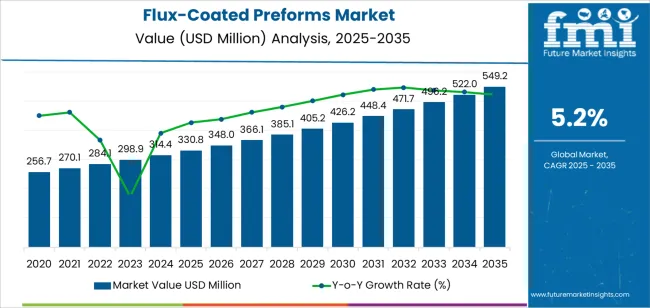
The subsequent period from 2030 to 2035 extends growth from USD 426.2 million to USD 549.1 million, adding USD 122.9 million or 56% of the decade's total expansion. This phase centers on widespread market penetration of specialized flux coating technologies, enhanced integration with automated assembly platforms, and expanded compatibility with diverse electronic manufacturing standards. Market development signals fundamental shifts in how manufacturers approach soldering process optimization and connection quality management, with industry participants positioned to capture demand across multiple flux type categories and application segments.
The flux-coated preforms market demonstrates distinct growth phases with varying market characteristics and competitive dynamics. Between 2025 and 2030, the market advances through its technology adoption phase, expanding from USD 330.8 million to USD 426.2 million with steady annual increments averaging 5.2% growth. This period showcases transition from basic flux coating formulations to advanced active flux systems with enhanced soldering capabilities and integrated quality control systems becoming mainstream features.
The 2025-2030 phase contributes USD 95.4 million to market value, representing 44% of total decade expansion. Market maturation factors include standardization of electronic assembly protocols, declining material costs for specialized flux formulations, and increasing manufacturer awareness of soldering reliability benefits reaching diverse electronics and semiconductor applications. Competitive landscape evolution during this period features established soldering material suppliers like Indium Corporation and Alpha expanding them preform portfolios while specialty manufacturers focus on advanced flux development and enhanced soldering capabilities.
From 2030 to 2035, market dynamics shift toward comprehensive automation integration and global manufacturing expansion, with growth continuing from USD 426.2 million to USD 549.1 million, adding USD 122.9 million or 56% of total expansion. This phase transition centers on specialized flux coating systems, integration with automated assembly networks, and deployment across diverse electronics and aerospace scenarios, becoming standard rather than specialized applications. The competitive environment matures with focus shifting from basic soldering capability to comprehensive process optimization systems and integration with manufacturing quality monitoring platforms.
| Metric | Value |
|---|---|
| Market Value (2025) | USD 330.8 million |
| Market Forecast (2035) | USD 549.1 million |
| Growth Rate | 5.2% CAGR |
| Leading Technology | Active Flux Type |
| Primary Application | Electronics and Semiconductor Segment |
The market demonstrates strong fundamentals with active flux systems capturing a dominant share through advanced soldering performance and process optimization capabilities. Electronics and semiconductor applications drive primary demand, supported by increasing electronic device production and soldering technology requirements. Geographic expansion remains concentrated in developed markets with established electronics manufacturing infrastructure, while emerging economies show accelerating adoption rates driven by semiconductor fabrication expansion and rising quality standards.
Market expansion rests on three fundamental shifts driving adoption across electronics, semiconductor, and aerospace sectors. First, manufacturing efficiency demand creates compelling operational advantages through flux-coated preforms that provide immediate soldering reliability and connection quality without compromising production throughput, enabling manufacturers to meet stringent assembly standards while maintaining manufacturing productivity and reducing defect rates. Second, electronics manufacturing modernization accelerates as assembly facilities worldwide seek advanced soldering systems that complement automated production processes, enabling precise flux application and joint quality that align with industry standards and reliability protocols.
Third, semiconductor assembly enhancement drives adoption from electronics manufacturers and chip packaging facilities requiring effective soldering solutions that maximize connection integrity while maintaining operational productivity during component assembly and substrate bonding operations. Growth faces headwinds from material cost challenges that vary across flux suppliers regarding specialty chemical formulations and coating technologies, which may limit adoption in cost-sensitive manufacturing environments. Technical limitations persist regarding flux activity constraints and material compatibility that may reduce effectiveness in lead-free soldering or high-temperature scenarios, affecting process capability and reliability requirements.
The flux-coated preforms market represents a specialized yet critical manufacturing opportunity driven by expanding global electronics production, semiconductor assembly modernization, and demand for superior soldering reliability in diverse industrial applications. As manufacturers worldwide seek to achieve consistent joint quality, reduce soldering defects, and integrate advanced preform systems with automated platforms, flux-coated preforms evolve from basic soldering materials to sophisticated assembly solutions ensuring connection quality and manufacturing leadership.
The market's growth trajectory from USD 330.8 million in 2025 to USD 549.1 million by 2035 at a 5.2% CAGR reflects fundamental shifts in electronics manufacturing requirements and soldering process optimization. Geographic expansion opportunities remain particularly pronounced in Asia Pacific markets, while the dominance of active flux systems and electronics applications provides clear strategic focus areas.
Strengthening the dominant active flux segment through enhanced chemical formulations, superior soldering performance, and integrated process control systems. This pathway focuses on optimizing flux chemistry, improving joint reliability, extending operational effectiveness across diverse soldering conditions, and developing specialized formulations for varied applications. Market leadership consolidation through advanced material engineering and automated process integration enables premium positioning while defending competitive advantages. Expected revenue pool: USD 35-48 million
Rapid electronics manufacturing and semiconductor assembly growth across Asia Pacific creates substantial expansion opportunities through local production capabilities and technology partnerships. Growing device production volumes and fabrication facility development drive persistent demand for advanced preform systems. Localization strategies reduce material costs, enable faster technical support, and position companies advantageously for electronics procurement programs. Expected revenue pool: USD 30-42 million
Expansion within the dominant electronics and semiconductor segment through specialized preform designs addressing assembly standards and production requirements. This pathway encompasses automated placement integration, quality verification coordination, and compatibility with diverse manufacturing workflows. Premium positioning reflects superior soldering capability and comprehensive quality compliance. Expected revenue pool: USD 28-38 million
Strategic expansion into military and aerospace applications requires enhanced reliability capabilities and specification-focused features addressing defense operational requirements. This pathway addresses extreme environment performance, long-term reliability verification, and military specification compliance with advanced materials for demanding aerospace applications. Premium pricing reflects specialized reliability requirements. Expected revenue pool: USD 24-33 million
Development of specialized flux-coated preforms for medical device applications addressing biocompatibility and regulatory requirements. This pathway encompasses sterilization compatibility, medical-grade materials, and regulatory compliance capabilities for healthcare electronics segments. Technology differentiation through certified formulations enables diversified revenue streams while reducing dependency on commercial electronics platforms. Expected revenue pool: USD 20-28 million
Expansion of inactive flux segment through enhanced stability properties, extended shelf life characteristics, and specialized manufacturing requirements. This pathway encompasses controlled atmosphere soldering, precision assembly applications, and low-residue formulations requiring superior flux stability characteristics. Market development through specialized chemistry enables differentiated positioning while accessing niche manufacturing requiring stable flux solutions. Expected revenue pool: USD 18-25 million
Development of environmentally compliant flux formulations addressing regulatory requirements and lead-free soldering standards across electronics applications. This pathway encompasses RoHS compliance, halogen-free formulations, and comprehensive environmental documentation. Premium positioning reflects regulatory leadership and environmental expertise while enabling access to environmentally-focused manufacturing programs and environmentally-driven electronics assembly. Expected revenue pool: USD 15-22 million
Primary Classification: The market segments by flux type into Active Flux and Inactive Flux categories, representing evolution from basic flux materials to specialized soldering solutions for comprehensive electronics manufacturing optimization.
Secondary Classification: Application segmentation divides the market into Electronics and Semiconductor, Military and Aerospace, Medical, and Others sectors, reflecting distinct requirements for soldering reliability, process capacity, and quality assurance standards.
Regional Classification: Geographic distribution covers Asia Pacific, Europe, North America, and other regions, with developed markets leading adoption while emerging economies show accelerating growth patterns driven by electronics manufacturing expansion programs.
The segmentation structure reveals progression from standard flux formulations toward specialized coating systems with enhanced performance and reliability capabilities, while application diversity spans from electronics assembly to specialized aerospace and medical device manufacturing requiring precise soldering solutions.
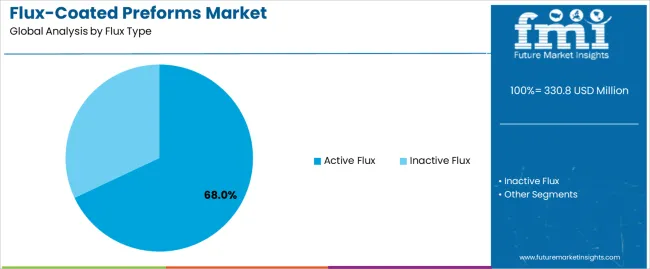
Market Position: Active flux systems command the leading position in the flux-coated preforms market with approximately 68% market share through advanced chemical properties, including superior oxide removal, enhanced wetting capability, and process optimization that enable manufacturers to achieve optimal soldering reliability across diverse electronics and semiconductor environments.
Value Drivers: The segment benefits from manufacturer preference for effective flux systems that provide consistent soldering performance, reduced defect rates, and process reliability without requiring extensive process modifications. Advanced chemical features enable automated assembly integration, quality consistency, and compatibility with existing manufacturing equipment, where flux performance and soldering reliability represent critical production requirements.
Competitive Advantages: Active flux systems differentiate through proven soldering effectiveness, consistent chemical characteristics, and integration with automated assembly platforms that enhance operational efficiency while maintaining optimal joint quality suitable for diverse electronics applications.
Key market characteristics:
Inactive flux systems maintain specialized positioning in the flux-coated preforms market due to their stability properties and controlled environment advantages. These systems appeal to manufacturers requiring stable flux materials with adequate performance for specialized soldering applications. Market adoption is driven by precision assembly operations and controlled atmosphere manufacturing, emphasizing process stability and material consistency through optimized flux formulations while maintaining specialized application requirements.
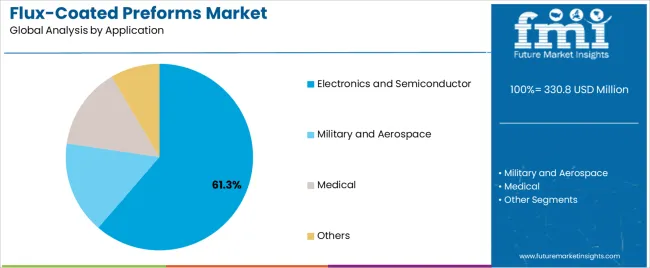
Market Context: Electronics and semiconductor applications dominate the flux-coated preforms market with approximately 61.3% market share due to widespread adoption of advanced soldering materials and increasing focus on connection reliability, manufacturing quality, and assembly process management that minimize production defects while maintaining electronics manufacturing standards.
Appeal Factors: Electronics manufacturers prioritize soldering reliability, process consistency, and integration with existing assembly infrastructure that enables coordinated preform application across multiple production lines. The segment benefits from substantial manufacturing investment and capital equipment procurement programs that emphasize acquisition of soldering materials for quality assurance and process optimization applications.
Growth Drivers: Electronics manufacturing expansion programs incorporate flux-coated preforms as standard assembly materials for semiconductor packaging operations, while advanced device production growth increases demand for specialized soldering capabilities that comply with reliability standards and minimize connection failures.
Market Challenges: Varying manufacturing protocols and assembly process differences may limit material standardization across different production facilities or operational scenarios.
Application dynamics include:
Military and aerospace applications capture approximately 22.3% market share through specialized soldering requirements in defense electronics manufacturing, aerospace component assembly, and military equipment production. These facilities demand robust preform systems capable of providing extreme reliability while delivering mission-critical performance and long-term connection integrity capabilities.
Medical applications account for approximately 10.3% market share, while other segments capture 6.1%, including industrial electronics assembly, automotive electronics manufacturing, and specialty soldering applications requiring flux-coated preform capabilities for quality positioning and reliability compliance.
Growth Accelerators: Electronics production expansion drives primary adoption as flux-coated preforms provide superior soldering reliability capabilities that enable manufacturers to meet stringent quality standards without excessive material costs, supporting assembly operations and production objectives that require precise connection formation applications. Manufacturing infrastructure demand accelerates market expansion as electronics facilities seek effective automated systems that minimize soldering defects while maintaining operational effectiveness during component assembly and substrate bonding scenarios. Industrial spending increases worldwide, creating continued demand for soldering material systems that complement automated assembly processes and provide connection reliability in competitive markets.
Growth Inhibitors: Material cost challenges vary across flux suppliers regarding specialty chemical formulations and coating process technologies, which may limit operational flexibility and market penetration in regions with price-sensitive electronics operations. Technical performance limitations persist regarding flux activity constraints and lead-free compatibility that may reduce effectiveness in high-temperature, reflow soldering, or specialty alloy conditions, affecting process capability and reliability requirements. Market fragmentation across multiple assembly standards and soldering specifications creates compatibility concerns between different preform manufacturers and existing production infrastructure.
Market Evolution Patterns: Adoption accelerates in semiconductor packaging and advanced electronics sectors where soldering reliability justifies material costs, with geographic concentration in developed markets transitioning toward mainstream adoption in emerging economies driven by electronics manufacturing expansion and quality awareness. Technology development focuses on enhanced flux chemistries, improved environmental compliance, and compatibility with lead-free soldering systems that optimize connection quality and process effectiveness. The market could face disruption if alternative joining technologies or solder paste innovations significantly limit deployment of preform-based soldering in electronics applications, though flux-coated preforms' unique combination of placement precision, material consistency, and automated compatibility continues making them preferred in advanced assembly operations.
The flux-coated preforms market demonstrates varied regional dynamics with Growth Leaders including China (7.0% CAGR) and India (6.5% CAGR) driving expansion through electronics manufacturing capacity additions and semiconductor fabrication expansion programs. Steady Performers encompass Germany (6.0% CAGR), Brazil (5.5% CAGR), and United States (4.9% CAGR), benefiting from established electronics industries and advanced soldering technology adoption. Mature Markets feature United Kingdom (4.4% CAGR) and Japan (3.9% CAGR), where specialized aerospace applications and premium electronics integration support consistent growth patterns.

| Country | CAGR (2025-2035) |
|---|---|
| China | 7.0% |
| India | 6.5% |
| Germany | 6.0% |
| Brazil | 5.5% |
| United States | 4.9% |
| United Kingdom | 4.4% |
| Japan | 3.9% |
Regional synthesis reveals Asia Pacific markets leading adoption through electronics manufacturing expansion and semiconductor assembly development, while European countries maintain steady expansion supported by aerospace technology advancement and automotive electronics standardization requirements. North American markets show moderate growth driven by defense electronics applications and advanced manufacturing integration trends.

The Chinese market emphasizes advanced soldering features, including precision flux application and integration with comprehensive electronics manufacturing platforms that manage assembly quality, process optimization, and reliability applications through unified production systems. The country demonstrates strong growth at 7.0% CAGR, driven by electronics manufacturing expansion, semiconductor fabrication initiatives, and emerging advanced assembly development that support preform integration. Chinese electronics manufacturers prioritize operational effectiveness with flux-coated preforms delivering consistent soldering performance through advanced material capabilities and production adaptation features.
Distribution channels include major electronics manufacturers, semiconductor packaging facilities, and industrial material procurement programs that support professional applications for complex assembly operations and chip packaging applications. Manufacturing platform integration capabilities with established electronics systems expand market appeal across diverse operational requirements seeking soldering reliability and efficiency benefits. The expanding consumer electronics production and accelerating semiconductor industry create continued demand, while innovative applications in 5G technology and electric vehicles open new growth avenues.
Performance Metrics:
Advanced electronics market in Germany demonstrates sophisticated preform deployment with documented operational effectiveness in automotive electronics applications and aerospace component facilities through integration with existing assembly systems and manufacturing infrastructure. The country leverages engineering expertise in soldering technology and production systems integration to maintain strong growth at 6.0% CAGR. Industrial centers, including Munich, Stuttgart, and Frankfurt, showcase premium installations where preform systems integrate with comprehensive manufacturing platforms and quality management systems to optimize assembly effectiveness and connection reliability.
German material suppliers prioritize system reliability and manufacturing compliance in preform development, creating demand for premium soldering systems with advanced features, including process integration and quality verification systems. The market benefits from established automotive electronics infrastructure and willingness to invest in soldering technologies that provide long-term manufacturing benefits and compliance with automotive quality standards.
Market Intelligence Brief:
The USA flux-coated preforms market demonstrates sophisticated deployment across aerospace electronics applications with documented effectiveness in defense systems manufacturing and advanced electronics facilities through integration with comprehensive manufacturing platforms and quality infrastructure. The country leverages advanced technology capabilities in materials innovation and assembly process optimization to maintain moderate growth at 4.9% CAGR. Manufacturing centers, including major aerospace hubs, showcase premium installations where preform systems integrate with comprehensive quality platforms and defense supply networks to optimize reliability positioning and manufacturing effectiveness.
American electronics manufacturers prioritize connection reliability and process control in material selection, creating demand for innovative preform systems with advanced features, including traceability integration and automated process monitoring. The market benefits from established aerospace infrastructure and willingness to invest in soldering technologies that provide quality enhancement and compliance with military and aerospace standards.
Market Intelligence Brief:
The UK flux-coated preforms market demonstrates advanced aerospace deployment with documented operational effectiveness in defense electronics applications and specialty manufacturing through integration with existing assembly systems and production infrastructure. The country leverages expertise in aerospace manufacturing and production systems integration to maintain steady growth at 4.4% CAGR. Manufacturing centers, including aerospace facilities in Bristol, Farnborough, and Manchester, showcase installations where preform systems integrate with comprehensive quality platforms and manufacturing systems to optimize defense compliance and assembly effectiveness.
British manufacturers prioritize system traceability and military compliance in material development, creating demand for certified preform systems with advanced features, including defense specification compliance and quality data management. The market benefits from established aerospace infrastructure and commitment to invest in soldering technologies that provide reliability benefits and compliance with UK defense standards.
Strategic Market Indicators:
Flux-coated preforms market in India demonstrates rapid expansion with documented operational effectiveness in electronics manufacturing applications and semiconductor assembly facilities through integration with emerging production systems and manufacturing infrastructure. The country leverages growing electronics capabilities in assembly technology and manufacturing systems integration to achieve high growth at 6.5% CAGR. Manufacturing centers, including Bangalore, Pune, and Chennai, showcase expanding installations where preform systems integrate with comprehensive electronics platforms and supply networks to optimize market penetration and manufacturing effectiveness.
Indian electronics manufacturers prioritize production quality and cost standards in material selection, creating demand for effective preform systems with advanced features, including automated process integration and quality control systems. The market benefits from expanding electronics infrastructure and willingness to invest in international-standard soldering technologies that provide manufacturing differentiation and compliance with quality standards.
Market Intelligence Brief:
Flux-coated preforms market in Brazil demonstrates expansion with documented operational effectiveness in electronics assembly applications and industrial manufacturing facilities through integration with developing production systems and electronics infrastructure. The country leverages growing manufacturing capabilities in assembly technology and production integration to achieve growth at 5.5% CAGR. Manufacturing centers, including São Paulo, Campinas, and Manaus, showcase installations where preform systems integrate with electronics platforms and supply networks to optimize market development and manufacturing effectiveness.
Brazilian electronics manufacturers prioritize material value and production capability in preform selection, creating demand for cost-effective soldering systems with reliable features, including standard quality and manufacturing compatibility. The market benefits from expanding electronics infrastructure and investment in assembly materials that provide production enhancement.
Market Intelligence Brief:
Flux-coated preforms market in Japan demonstrates precision deployment with documented operational effectiveness in advanced electronics applications and specialty semiconductor facilities through integration with sophisticated manufacturing systems and quality control infrastructure. The country leverages engineering excellence in precision assembly and manufacturing systems integration to maintain steady growth at 3.9% CAGR. Manufacturing centers, including Tokyo, Osaka, and Nagoya, showcase installations where preform systems integrate with comprehensive quality platforms and production management systems to optimize manufacturing excellence and soldering effectiveness.
Japanese electronics manufacturers prioritize system precision and material excellence in preform development, creating demand for premium soldering systems with advanced features, including micro-precision application and quality integration systems. The market benefits from established electronics infrastructure and commitment to invest in highest-quality soldering technologies that provide superior manufacturing positioning and compliance with rigorous Japanese quality standards.
Strategic Market Indicators:
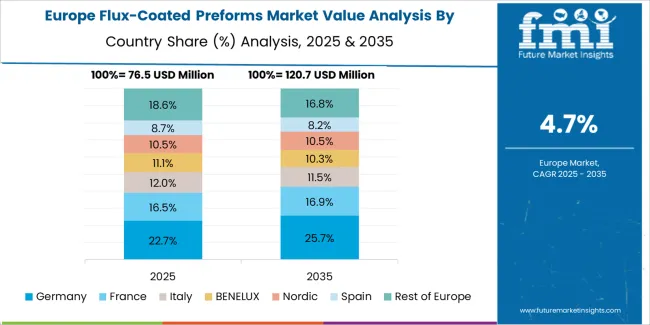
The flux-coated preforms market in Europe is projected to grow from USD 85.6 million in 2025 to USD 141.9 million by 2035, registering a CAGR of 5.2% over the forecast period. Germany is expected to maintain its leadership position with a 30.2% market share in 2025, projected to reach 31.4% by 2035, supported by its advanced automotive electronics infrastructure and major manufacturing centers in Munich and Stuttgart. France follows with a 19.8% share in 2025, expected to reach 20.5% by 2035, driven by comprehensive aerospace programs and electronics manufacturing initiatives.
The United Kingdom holds a 16.7% share in 2025, projected to reach 17.2% by 2035 through specialized defense electronics activities and aerospace component manufacturing. Italy commands a 13.4% share, while Spain accounts for 10.6% in 2025. The Netherlands maintains a 4.5% share. The Rest of Europe region is anticipated to show steady adoption, with its collective share remaining at 4.8% through 2035, reflecting consistent growth in Nordic countries and emerging Central European electronics markets implementing advanced manufacturing programs.
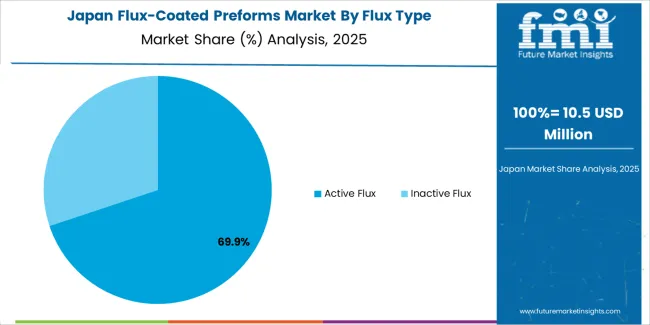
In Japan, the flux-coated preforms market prioritizes active flux systems, which capture the dominant share of electronics manufacturing and semiconductor assembly installations due to their advanced features, including precision soldering optimization and seamless integration with existing production infrastructure. Japanese electronics manufacturers emphasize reliability, performance, and long-term quality excellence, creating demand for active flux systems that provide consistent soldering capabilities and superior connection performance based on manufacturing requirements and quality standards. Inactive flux maintains secondary positions primarily in controlled atmosphere applications and specialty manufacturing installations where specific process functionality meets operational requirements without compromising assembly efficiency.
Market Characteristics:
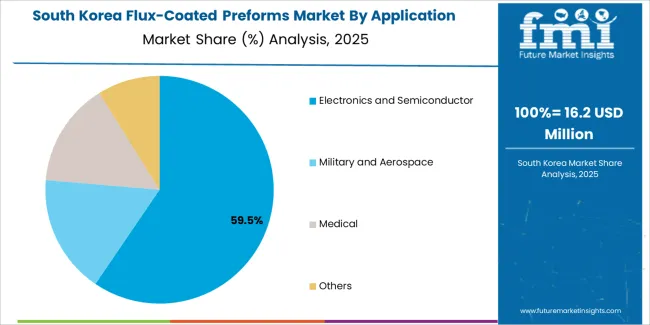
In South Korea, the market structure favors international soldering material manufacturers, including Indium Corporation, Alpha, and Ametek, which maintain dominant positions through comprehensive product portfolios and established electronics networks supporting both semiconductor fabrication and electronics assembly installations. These providers offer integrated solutions combining advanced preform systems with professional technical services and ongoing application support that appeal to Korean manufacturers seeking reliable soldering material systems. Local material distributors capture moderate market shares by providing localized service capabilities and competitive pricing for standard manufacturing applications, while domestic suppliers focus on specialized applications and cost-effective solutions tailored to Korean electronics market characteristics.
Channel Insights:
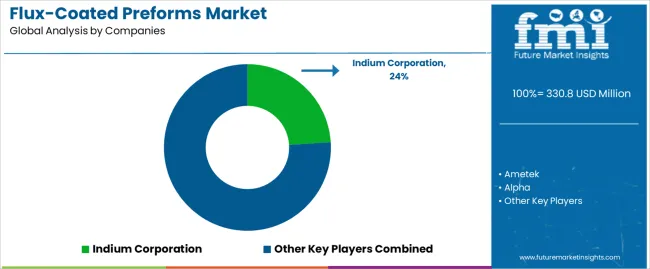
The flux-coated preforms market operates with moderate concentration, featuring approximately 10-15 meaningful participants, where leading companies control roughly 50-55% of the global market share through established electronics manufacturing relationships and comprehensive soldering material portfolios. Competition emphasizes advanced flux formulations, process reliability, and manufacturing integration rather than price-based rivalry. The leading company, Indium Corporation, commands approximately 24% market share through its extensive soldering materials product line and global electronics industry presence.
Market Leaders encompass Indium Corporation, Alpha, and Ametek, which maintain competitive advantages through extensive soldering technology expertise, global electronics networks, and comprehensive manufacturing integration capabilities that create customer loyalty and support premium pricing. These companies leverage decades of materials science experience and ongoing innovation investments to develop advanced preform systems with precision flux control and reliability features. Technology Innovators include SMIC, Pfarr, and regional specialists, which compete through specialized formulation focus and innovative soldering capabilities that appeal to manufacturers seeking advanced assembly solutions and process differentiation.
These companies differentiate through rapid material development cycles and specialized semiconductor application focus. Regional Specialists feature material manufacturers focusing on specific geographic markets and specialized applications, including military-grade systems and integrated manufacturing solutions. Market dynamics favor participants that combine reliable flux performance with advanced coating capabilities, including precision application control and process optimization features. Competitive pressure intensifies as traditional soldering material suppliers expand into flux-coated preform systems, while specialized materials companies challenge established players through innovative formulation solutions and automation platforms targeting premium electronics and aerospace manufacturing segments.
| Item | Value |
|---|---|
| Quantitative Units | USD 330.8 million |
| Flux Type | Active Flux, Inactive Flux |
| Application | Electronics and Semiconductor, Military and Aerospace, Medical, Others |
| Regions Covered | Asia Pacific, Europe, North America, Latin America, Middle East & Africa |
| Countries Covered | China, India, Germany, Brazil, United States, United Kingdom, Japan, and 20+ additional countries |
| Key Companies Profiled | SMIC, Indium Corporation, Ametek, Alpha, Pfarr, Harris Products, AIM, Zhejiang YaTong Advanced Materials, Solderwell Advanced Materials, Fromosol, Guangdong Zhongshi Metal Co, Shenmao |
| Additional Attributes | Dollar sales by flux type and application categories, regional adoption trends across Asia Pacific, Europe, and North America, competitive landscape with soldering material manufacturers and electronics suppliers, manufacturer preferences for reliability and process optimization, integration with automated assembly platforms and quality monitoring systems, innovations in flux formulations and coating technologies, and development of lead-free solutions with enhanced performance and manufacturing optimization capabilities. |
The global flux-coated preforms market is estimated to be valued at USD 330.8 million in 2025.
The market size for the flux-coated preforms market is projected to reach USD 549.2 million by 2035.
The flux-coated preforms market is expected to grow at a 5.2% CAGR between 2025 and 2035.
The key product types in flux-coated preforms market are active flux and inactive flux.
In terms of application, electronics and semiconductor segment to command 61.3% share in the flux-coated preforms market in 2025.






Full Research Suite comprises of:
Market outlook & trends analysis
Interviews & case studies
Strategic recommendations
Vendor profiles & capabilities analysis
5-year forecasts
8 regions and 60+ country-level data splits
Market segment data splits
12 months of continuous data updates
DELIVERED AS:
PDF EXCEL ONLINE
Flux-Coated Preforms for Semiconductor Market Size and Share Forecast Outlook 2025 to 2035

Thank you!
You will receive an email from our Business Development Manager. Please be sure to check your SPAM/JUNK folder too.
Chat With
MaRIA